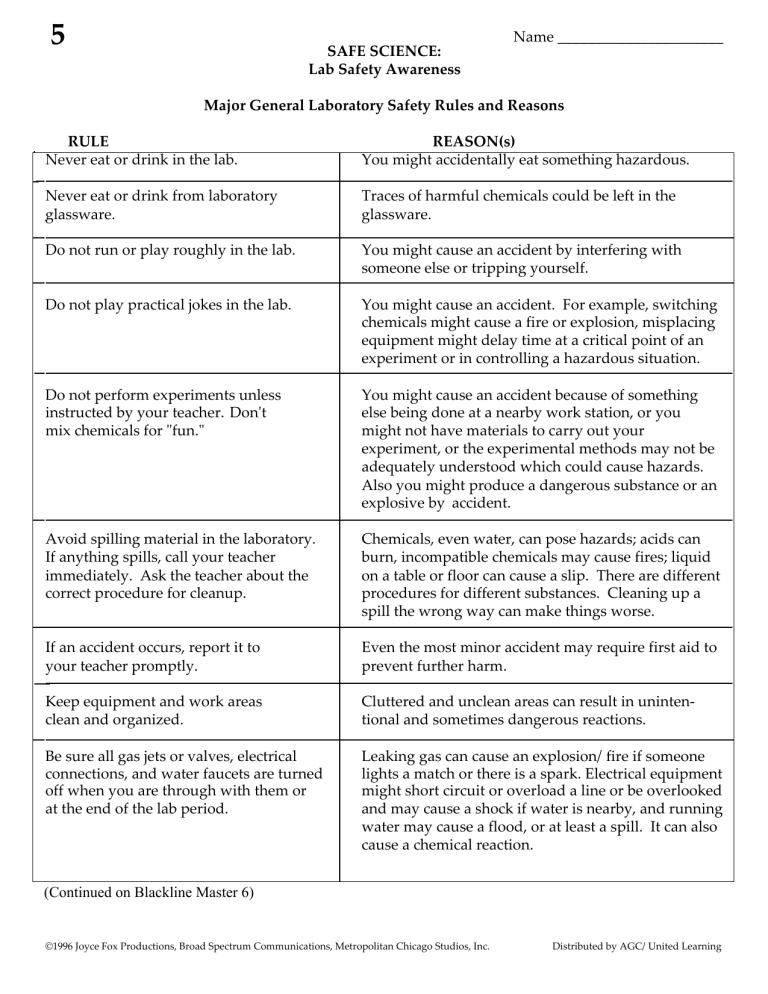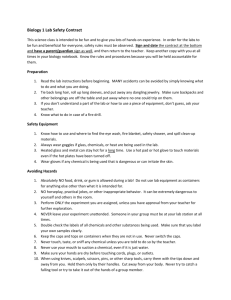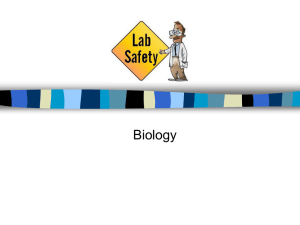
5 SAFE SCIENCE: Lab Safety Awareness Name ______________________ Major General Laboratory Safety Rules and Reasons RULE Never eat or drink in the lab. REASON(s) You might accidentally eat something hazardous. Never eat or drink from laboratory glassware. Traces of harmful chemicals could be left in the glassware. Do not run or play roughly in the lab. You might cause an accident by interfering with someone else or tripping yourself. Do not play practical jokes in the lab. You might cause an accident. For example, switching chemicals might cause a fire or explosion, misplacing equipment might delay time at a critical point of an experiment or in controlling a hazardous situation. Do not perform experiments unless instructed by your teacher. Don't mix chemicals for "fun." You might cause an accident because of something else being done at a nearby work station, or you might not have materials to carry out your experiment, or the experimental methods may not be adequately understood which could cause hazards. Also you might produce a dangerous substance or an explosive by accident. Avoid spilling material in the laboratory. If anything spills, call your teacher immediately. Ask the teacher about the correct procedure for cleanup. Chemicals, even water, can pose hazards; acids can burn, incompatible chemicals may cause fires; liquid on a table or floor can cause a slip. There are different procedures for different substances. Cleaning up a spill the wrong way can make things worse. If an accident occurs, report it to your teacher promptly. Even the most minor accident may require first aid to prevent further harm. Keep equipment and work areas clean and organized. Cluttered and unclean areas can result in unintentional and sometimes dangerous reactions. Be sure all gas jets or valves, electrical connections, and water faucets are turned off when you are through with them or at the end of the lab period. Leaking gas can cause an explosion/fire if someone lights a match or there is a spark. Electrical equipment might short circuit or overload a line or be overlooked and may cause a shock if water is nearby, and running water may cause a flood, or at least a spill. It can also cause a chemical reaction. (Continued on Blackline Master 6) ©1996 Joyce Fox Productions, Broad Spectrum Communications, Metropolitan Chicago Studios, Inc. Distributed by AGC/United Learning 6 SAFE SCIENCE: Lab Safety Awareness Name ______________________ Major General Laboratory Safety Rules and Reasons (Continued) RULE Wear eye protection, aprons or lab coats, closed-toe shoes and other safety protection as directed by your teacher or the instructions in your book. REASON(s) Fragments of glass or harmful substances can damage eyes. Clothing should be protected to minimize risk of fire or burning, or other harm to clothes and skin. Exposed toes may be damaged by sharp objects or substances that burn or cause other damage to tissue. Read labels on containers with care before using their contents. Materials with similar names or concentrations may react very differently. Carry microscopes and other pieces of equipment with both hands, using one hand to support the instrument from underneath. It is easy to drop a heavy piece of equipment if you are jarred or surprised or simply trip. This could hurt you as well as what you are carrying! Follow instructions with care about the handling and management of live animals. The care and safety of live animals should always be of major concern. Follow safety instructions precisely as stated in your book and/or by your teacher. Always obtain permission from your teacher before experimenting on your own. Do not perform any activities that have not been approved by your teacher. A small change in a method can make a big change in what happens, and while you should be prepared for the unexpected, prevention of harm is always better than minimizing harm. You may not be aware of what someone near you will do and vice-versa. Never use broken or chipped glassware. If you notice a chip, crack, or break, inform your teacher immediately. Dispose of the glassware in the proper container. Glassware that is chipped, cracked or broken can cause cuts. Material placed in broken or chipped glassware may leak. Glassware that is not intact may crack when heated. If squeezed or bumped or shocked by change in temperature, damaged glassware can break relatively easily. Learn the meaning of every safety symbol used in the lab. Symbols will remind you of hazards and how to prevent accidents and protect yourself. Always wash your hands after each laboratory experiment, or whenever your hands have been exposed to anything that might harm you. It is a good habit to avoid risk of exposure to anything that may hurt your skin or damage your tissue in any way. (Continued on Blackline Master 7) ©1996 Joyce Fox Productions, Broad Spectrum Communications, Metropolitan Chicago Studios, Inc. Distributed by AGC/United Learning 7 SAFE SCIENCE: Lab Safety Awareness Name ______________________ Major General Laboratory Safety Rules and Reasons (Continued) RULE Wash your hands after handling animals or animal cages. REASON(s) Your hands may have come in contact with fecal material or other matter in the cage that may cause you harm. Read instructions for an experiment several times. Be sure you understand each of them. Follow directions exactly. For example, add acid to water, not water to acid. If you are not sure about any part of the directions, ask your teacher for help. Mixing some combinations of materials (in cluding water) can cause accidents. Heating certain materials or combinations of materials can cause accidents. If someone near you is working with chemicals (including water), fire, bulky equipment or tubing that may interfere with what you are doing, it could cause an accident. Never return chemicals to their original containers. Dispose of extra material you do not need according to your teacher's directions. Putting chemicals back in their original containers may cause contamination and therefore, unpredictable reactions. ©1996 Joyce Fox Productions, Broad Spectrum Communications, Metropolitan Chicago Studios, Inc. Distributed by AGC/United Learning


